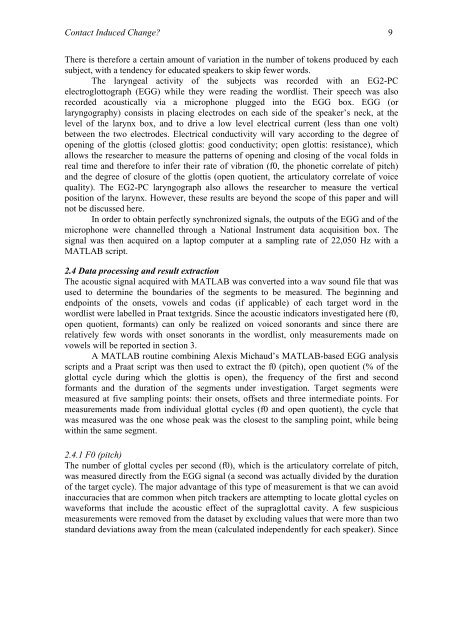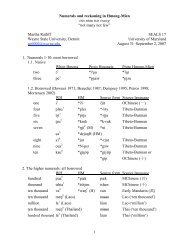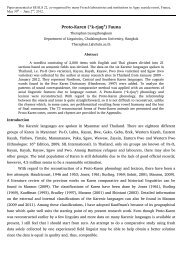proto-southwestern-tai revised: a new reconstruction - seals 22
proto-southwestern-tai revised: a new reconstruction - seals 22
proto-southwestern-tai revised: a new reconstruction - seals 22
You also want an ePaper? Increase the reach of your titles
YUMPU automatically turns print PDFs into web optimized ePapers that Google loves.
Contact Induced Change? 9<br />
There is therefore a cer<strong>tai</strong>n amount of variation in the number of tokens produced by each<br />
subject, with a tendency for educated speakers to skip fewer words.<br />
The laryngeal activity of the subjects was recorded with an EG2-PC<br />
electroglottograph (EGG) while they were reading the wordlist. Their speech was also<br />
recorded acoustically via a microphone plugged into the EGG box. EGG (or<br />
laryngography) consists in placing electrodes on each side of the speaker’s neck, at the<br />
level of the larynx box, and to drive a low level electrical current (less than one volt)<br />
between the two electrodes. Electrical conductivity will vary according to the degree of<br />
opening of the glottis (closed glottis: good conductivity; open glottis: resistance), which<br />
allows the researcher to measure the patterns of opening and closing of the vocal folds in<br />
real time and therefore to infer their rate of vibration (f0, the phonetic correlate of pitch)<br />
and the degree of closure of the glottis (open quotient, the articulatory correlate of voice<br />
quality). The EG2-PC laryngograph also allows the researcher to measure the vertical<br />
position of the larynx. However, these results are beyond the scope of this paper and will<br />
not be discussed here.<br />
In order to ob<strong>tai</strong>n perfectly synchronized signals, the outputs of the EGG and of the<br />
microphone were channelled through a National Instrument data acquisition box. The<br />
signal was then acquired on a laptop computer at a sampling rate of <strong>22</strong>,050 Hz with a<br />
MATLAB script.<br />
2.4 Data processing and result extraction<br />
The acoustic signal acquired with MATLAB was converted into a wav sound file that was<br />
used to determine the boundaries of the segments to be measured. The beginning and<br />
endpoints of the onsets, vowels and codas (if applicable) of each target word in the<br />
wordlist were labelled in Praat textgrids. Since the acoustic indicators investigated here (f0,<br />
open quotient, formants) can only be realized on voiced sonorants and since there are<br />
relatively few words with onset sonorants in the wordlist, only measurements made on<br />
vowels will be reported in section 3.<br />
A MATLAB routine combining Alexis Michaud’s MATLAB-based EGG analysis<br />
scripts and a Praat script was then used to extract the f0 (pitch), open quotient (% of the<br />
glottal cycle during which the glottis is open), the frequency of the first and second<br />
formants and the duration of the segments under investigation. Target segments were<br />
measured at five sampling points: their onsets, offsets and three intermediate points. For<br />
measurements made from individual glottal cycles (f0 and open quotient), the cycle that<br />
was measured was the one whose peak was the closest to the sampling point, while being<br />
within the same segment.<br />
2.4.1 F0 (pitch)<br />
The number of glottal cycles per second (f0), which is the articulatory correlate of pitch,<br />
was measured directly from the EGG signal (a second was actually divided by the duration<br />
of the target cycle). The major advantage of this type of measurement is that we can avoid<br />
inaccuracies that are common when pitch trackers are attempting to locate glottal cycles on<br />
waveforms that include the acoustic effect of the supraglottal cavity. A few suspicious<br />
measurements were removed from the dataset by excluding values that were more than two<br />
standard deviations away from the mean (calculated independently for each speaker). Since





